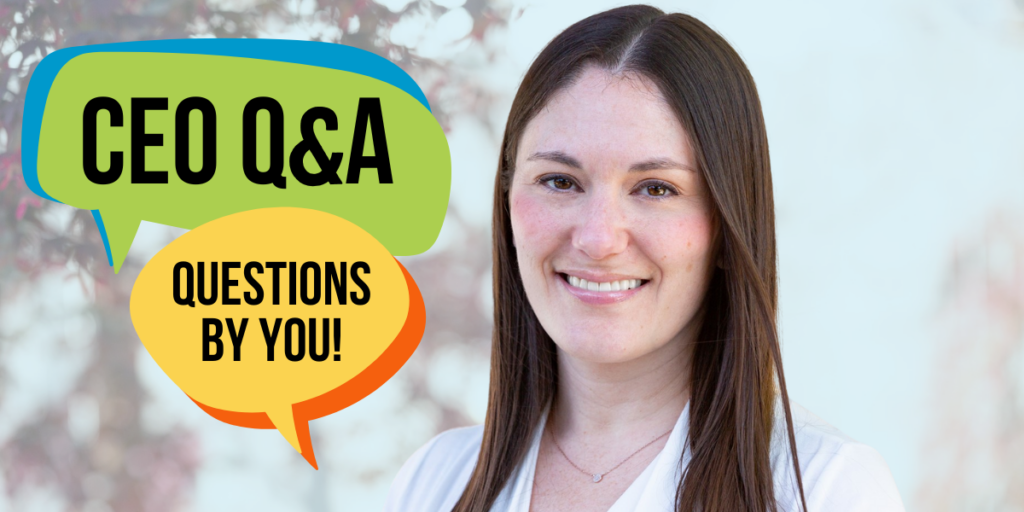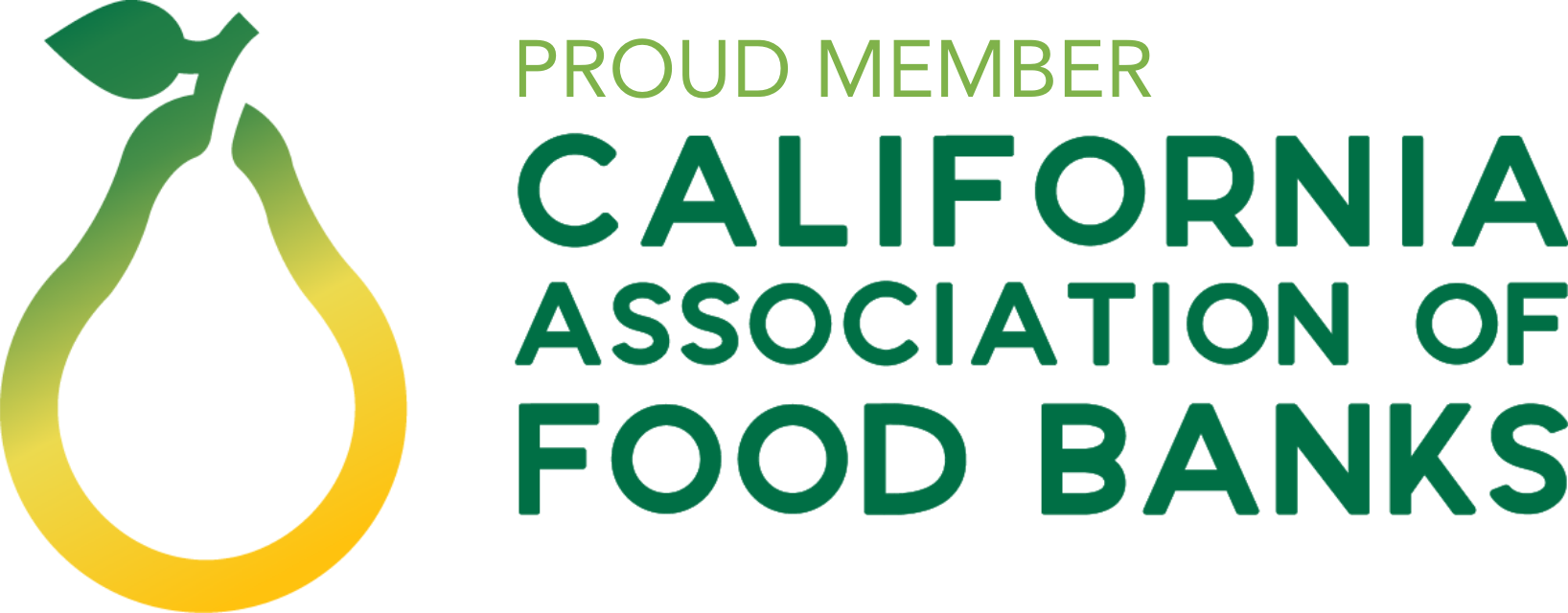We asked our email newsletter subscribers what they wanted to know about our new President and CEO, Caitlin Sly – and they had so many great questions!
Before joining us in her current role, Caitlin served as CEO at Meals on Wheels Diablo Region. Prior to that she worked here at the Food Bank, most recently serving as our Director of Programs.
Check out the Q&A below to learn more about her vision for the Food Bank, what brings her hope in the fight against hunger, her favorite vegetable – and more!
Q: When do you remember first learning about hunger?
Food insecurity and hunger were a constant growing up. It was something that I would overhear the adults talking about at Thanksgiving at the dinner table, at Christmas. Anytime my family would get together, my dad (former Food Bank President and CEO Larry Sly) and my uncle and my aunts would be talking shop.
And then I would be volunteering on the weekends and doing different food drives and coming into the Food Bank office. So it was just a part of my childhood.
Q: Why is food security so important to you now?
I’m a lifelong Bay Area native and it’s really hard for me to see the disparities in the Bay Area between the rich and the poor.
Some of us, myself included, have no problem affording really delicious food. And then there’s people who are lining up at our distributions to get green beans and bread and just the basics. That has always felt incredibly unjust to me.
Food is such a basic need that is so important to all of us, and it’s so much more than filling your body. We build community, we build family, we build all of these things around food. And for there to be people in our backyard that cannot afford that just does not sit well with me.
Q: What did you focus on academically and what surprised you during that journey? How does that inform your current work?
I studied Latin American history and Spanish. I think it does help me every day, because you can’t really understand people without understanding their history, or understand culture without understanding what has led up to it. I feel like it gives me a better perspective on why our services are needed because of the historical context.
Q: What’s been the most surprising thing about returning to the Food Bank?
The sheer volume of the work has been the most surprising. The new warehouse in Fairfield is massive and full. To have a building that is 100,000 square feet, that is about 80% full of food, is huge.
And just the amount of people we’re serving, and the amount we’ve grown to meet that demand was surprising. I knew we’d grown, but I didn’t really know by how much until I got to see it.
Q: What are you looking forward to the most in your first year as CEO?
I’m really looking forward to getting some of our current long-term projects – like our new upgraded volunteer centers and our warehouse modernization project – wrapped up and done, and then looking towards the future.
Q: Is there anything that you learned at Meals on Wheels Diablo Region that you hope to bring to the Food Bank?
My work with Meals on Wheels gave me more of an appreciation for what older adults face when it comes to food insecurity – and also how many barriers there can be to getting food depending on who you are and what your circumstances are.
In the Meals on Wheels case, many of the barriers are physical. If a senior can’t get out of the house because they can’t stand long enough to cook for themselves, all the groceries in the world aren’t going to help.
I think understanding all of those contributing factors will help inform my work here and how we can better meet different populations where they’re at.
Q: What concerns you the most about the food security landscape right now and what gives you the most hope?
I think that the general public thinks that they gave during COVID and they’re done. So that concerns me. I’m obviously painting with a very broad definition – that’s not everyone. But we’re not the only nonprofit that is facing it.
What gives me the most hope is the strong partnerships that we have, and the really giving community that we are privileged to be in. And we have a lot of really strong nonprofit partnerships and great relationships with elected officials. I hope that we can build upon that to overcome some of those challenges.
Q: Where do you see the food bank in five years?
I think we have to get at the root causes of hunger, because otherwise we’re going to continue to serve more and more people every single month and essentially be providing a stopgap.
The last time we studied this, the root causes we saw in Contra Costa and Solano Counties were housing, people not making a living wage and medical expenses. And now certainly there’s the rising cost of food.
If we really want to fill the hunger gap or reduce food insecurity, then we need to work on those things.
I don’t think that needs to be us doing everything. I think we can do that through partnerships. Obviously we’re not the experts in job training or advocating for affordable housing, but we’re lucky to have community partners that do that kind of work. I think we can strengthen how we work together and support them.
Q: What is the food bank doing to improve the quality of the food it distributes?
I think the food we give out is very good quality. I don’t have many worries about that, but I think we could be giving out more variety.
I would love to see us offering more specialized food, whether it’s culturally appropriate food, or foods that work better for special diets. For example not all the food we pick out works with seniors’ digestion or teeth issues, or we might want to offer food that meets specific nutrition needs for kids.
We’ll need to survey our clients to find out what that means, because obviously it’s not going to be the same everywhere. We definitely have certain areas that would prefer certain food.
Q: I’m concerned about our environment – what can the food bank do to reduce its plastic use?
I know reducing our environmental footprint, including our plastic use, is a priority for Darwin Bosen, our Vice President of Programs and Operations. One option we’ve tried before is giving out reusable bags donated by our corporate partners, and I think that’s something we can explore again.
Q: What’s been your proudest hunger fighting achievement?
I think the hand that I had to create some of our programs here, specifically Farm 2 Kids and the Community Produce Program. Obviously I didn’t do that single handedly, but there were maybe two or three of us that basically grew and tested them. Getting to design these programs and see them to fruition and then see the effect – you don’t get much more rewarding.
Q: What do you like to do for fun?
Right now I really like to go out and hike with my dog, and just get out in nature as much as I can. That clears my head.
I also like doing jigsaw puzzles. That helps me de-stress. And I really like to travel. I haven’t been able to travel very much recently, but I really love different countries, different cultures and languages.
Q: What is your favorite vegetable?
Probably Brussels Sprouts or artichokes, but it’s hard to pick.
Be the first to know
Want an inside look at all things Food Bank – including opportunities to participate in Q&As like this one? Sign up for our email newsletter! You’ll receive updates on our programs and partners, volunteer opportunities and all the ways you are making an impact in the fight against hunger.




